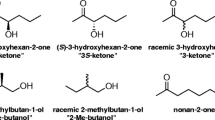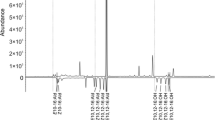Abstract
Ips pini from Idaho (ID) produce (−)-ipsdienol and respond to it in the laboratory.I. pini from New York (NY) produce (+) and (−)-ipsdienol in a 65∶35 ratio and respond much more strongly to the (+) than to the (−) enantiomer. Response byI. pini-ID to (−)-ipsdienol in the laboratory was inhibited by (+)-ipsdienol, while the field response byI. pini-NY was optimal to a 50:50 mixture of (+) and (−)-ipsdienol. This differential production and response to enantiomers of ipsdienol is sufficient to account for populational specificity observed in earlier experiments and confirmed by our current work. Reciprocal hybrids of the NY and IDI. pini populations did not differ in their patterns of attraction and response; those of both types of F1 were similar to NY beetles. Thus, it appears that (+)-ipsdienol is produced by the hybrids and is necessary for their maximum response, but this supposition was not tested. The genes controlling the pheromone biology ofI. pini are not sex linked. Since previous whole-antenna and single-cell electrophysiological data show that the receptor systems of the two populations are virtually identical, response behavior seems to be governed by the central nervous system rather than by the characteristics of the olfactory receptors.
Similar content being viewed by others
References
Angst, M.E., andLanier, G.N. 1979. Electroantennogram responses of two populations ofIps pini (Coleoptera: Scolytidae) to insect-produced and host tree compounds.J. Chem. Ecol. 5:129–138.
Birch, M.C. 1978. Chemical communication in bark beetles.Am. Sci. 66:409–419.
Birch, M.C., Light, D.M., Wood, D.L., Browne, L.E., Silverstein, R.M., Bergot, B.J., Ohloff, G., West, J.R., andYoung, J.C. 1980. Pheromonal attraction and allomonal interruption ofIps pini in California by the two enantiomers of ipsdienol.J. Chem. Ecol. 6:703–717.
Borden, J.H., Chang, L., McLean, J.A., Slessor, K.N., andMori, K. 1976.Gnathotrichus sulcatus: synergistic response to enantiomers of the aggregation pheromone sulcatol.Science 192:894–896.
Borden, J.H., Handley, J.R., McLean, J.A., Silverstein, R.M., Chang, L., Slessor, K.N., Johnson, B.D., andSchuler, H.R. 1980. Enantiomer-based specificity in pheromone communication by two sympatricGnathotrichus species.J. Chem. Ecol. 6:445–457.
Brownlee, R.G., andSilverstein, R.M. 1968. A micropreparative gas Chromatograph and a modified carbon skeleton determinator.Anal. Chem. 40:2077–2079.
Byrne, K.J., Gore, W.E., Pearce, G.T., andSilverstein, R.M. 1975. Porapak-Q collection of airborne organic compounds serving as models for insect pheromones.J. Chem. Ecol. 1:1–7.
Elliott, W.J., Hromnak, G., Fried, J., andLanier, G.N. 1979. Synthesis of multistriatin enantiomers and their action onScolytus multistriatus (Coleoptera: Scolytidae).J. Chem. Ecol. 5:279–287.
Grant, G.G., French, D., andGrisdale, D. 1975. Tussock moths: pheromone cross stimulation, calling behavior and effect of hybridization.Ann. Entomol. Soc. Am. 68:519–524.
Hopping, G.R. 1964. The North American species in groups IV and V ofIps De Geer (Coleoptera: Scolytidae).Can. Entomol. 96:970–978.
Klun, J., andMaini, S. 1979. Genetic basis of an insect chemical communication system: The European corn borer.Environ. Entomol. 8:423–426.
Lanier, G.N. 1970a. Sex pheromones: Abolition of specificity in hybrid bark beetles.Science 169:71–72.
Lanier, G.N. 1970b. Biosystematics of the genusIps (Coleoptera: Scolytidae) in North America. Hopping's group III.Can. Entomol. 102:1404–1423.
Lanier, G.N. 1972. Biosystematics of the genusIps (Coleoptera: Scolytidae) in North America. Hopping's groups IV and X.Can. Entomol. 104:361–388.
Lanier, G.N., andBurkholder, W.E. 1974. Pheromones in speciation of Coleoptera, pp. 161–189,in M.C. Birch (ed.) Pheromones. American Elsevier, New York.
Lanier, G.N., Birch, M.C., Schmitz, R.F., andFurniss, M.M. 1972. Pheromones ofIps pini (Coleoptera: Scolytidae): Variation in response among three populations.Can. Entomol. 104:1917–1923.
Lanier, G.N., Gore, W.E., Pearce, G.T., Peacock, J.W., andSilverstein, R.M. 1977. Response of the European elm bark beetle,Scolytus multistriatus (Coleoptera: Scolytidae), to isomers and components of its pheromone.J. Chem. Ecol. 3:1–8.
Moeck, H.A. 1970. An olfactometer for the bioassay of attractants for scolytids.Can. Entomol. 102:792–796.
Mustaparta, H., Angst, M.E., andLanier, G.N. 1980. Receptor discrimination of enantiomers of the aggregation pheromone ipsdienol in two species ofIps.J. Chem. Ecol. 6:689–701.
Ohloff, G., andGierch, W. 1977. Access to optically active ipsdienol from verbenone.Helv. Chim. Acta 60:1496–1500.
Piston, J.J., andLanier, G.N. 1974. Pheromones ofIps pini (Coleoptera: Scolytidae). Response to interpopulational hybrids and relative attractiveness of males boring in two host species.Can. Entomol. 106:247–251.
Roelofs, W.L., andCardé, R.T. 1974. Sex pheromones in the reproductive isolation of lepidopterous species, pp. 96–114,in M.C. Birch (ed.). Pheromones. American Elsevier, New York.
Sanders, C.J., Daterman, G.E., andEnnis, T.J. 1977. Sex pheromone response ofChoristoneura spp. and their hybrids (Lepidoptera: Tortricidae).Can. Entomol. 109:1203–1220.
Shorey, H.H. 1976. Animal Communication by Pheromones. Academic Press, New York. 167 pp.
Silverstein, R.M. 1979. Enantiomeric composition and bioactivity of chiral semiochemicals in insects, pp. 133–146,in F.J. Ritter (ed.). Chemical Ecology: Odour Communication in Animals. Elsevier, Amsterdam.
Vité, J.P., Bakke, A., andRenwick, J.A.A. 1972. Pheromones inIps (Coleoptera: Scolytidae): Occurrence and production.Can. Entomol. 104:1967–1975.
Wood, D.L., andBushing, R.W. 1963. The olfactory response ofIps confusus (LeConte) (Coleoptera: Scolytidae) to the secondary attraction in the laboratory.Can. Entomol. 95:1066–1078.
Young, J.C., Brownlee, R.G., Rodin, J.O., Hildebrand, D.N., Silverstein, R.M., Wood, D.L., Birch, M.C., andBrowne, L.E. 1973. Identification of linalool produced by two species of bark beetles of the genusIps.J. Insect Physiol. 19:1615–1622.
Author information
Authors and Affiliations
Additional information
Coleoptera: Scolytidae.
Supported by grants from the Rockefeller Institute, the National Science Foundation, and the Research Foundation of Providence, Rhode Island.
Rights and permissions
About this article
Cite this article
Lanier, G.N., Classon, A., Stewart, T. et al. IPS pini: The basis for interpopulational differences in pheromone biology. J Chem Ecol 6, 677–687 (1980). https://doi.org/10.1007/BF00987678
Received:
Revised:
Issue Date:
DOI: https://doi.org/10.1007/BF00987678




